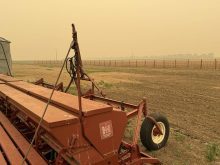Wheat with the Rht13 gene could be bred with other varieties to expand the production of climate resilient crops
Semi-dwarf wheat varieties have been used for decades, but they have limitations. The dwarfing aspect affects all stages of growth including the restricted growth of a seedling and the emergence of the first leaf and stem that will transport the young plant from its embryo stage to the soil surface, a process known as coleoptile.
To overcome these restrictions, researchers at the John Innes Centre at Norwich, United Kingdom, have discovered a new height-reducing gene named Rht13 that will allow seeds to be planted deeper in the soil with better access to moisture and with no adverse effect on each seedling’s early growth stages.
Read Also

Saskatchewan puts crown land auction on hold
Auctions of Saskatchewan crown lease land are once again on hold.
The potential is that varieties of wheat with the Rht13 gene could be efficiently bred with other wheat varieties to expand the production of reduced-height, climate resilient wheat varieties in regions with drier soil conditions.
“For several decades, we have known that the conventional semi-dwarfing genes have some disadvantages in certain environmental conditions,” said Philippa Borrill, group leader in the department of crop genetics at the John Innes Centre. “For example, in warm, dry environments farmers often sow the grains deeper to access soil moisture but the conventional dwarfing genes can prevent seedling emergence from the soil, resulting in patchy coverage and low yields. Conventional dwarfing genes reduce the height of all stages of plant growth, including coleoptile and seedling growth. Therefore, scientists and breeders have wanted to find alternative dwarfing genes without these drawbacks.”
She said that the first reduced-height wheat was a Japanese variety called Norin 10 released in 1935. The dwarf characteristic became widespread during the Green Revolution in the mid-20th century when a great increase in the production of food grains driven by improved agronomic practices led to huge yield increases.
“Varieties containing these conventional semi-dwarfing genes are extremely common,” she said. “Approximately 63 percent of cultivars released in the 21st century from a worldwide winter wheat panel contained one of these green revolution genes and the proportion is even higher (greater than 90 percent) in varieties bred for eastern and central U.S. However, the actual genes causing the reduced height characteristic were not identified until 1999.”
According to a news release, the Rht13 dwarf gene overcomes the problem of seedling emergence because the gene acts in tissues higher up the wheat stem. This puts the dwarfing mechanism into play once the seedling has emerged fully above ground, giving farmers critical advantage when planting deeper underground for moisture. But how this dwarf gene influence comes about is still not fully understood.
“Our current hypothesis is that the Rht13 gene is only active at later stages of plant growth once the stem is extending during booting. This is a question we plan to follow up in our future research,” said Borrill.
The Rht13 gene reduces the height of adult wheat plants by 15 to 35 percent depending on the variety and the growing conditions, which is comparable to the effect of conventional semi-dwarfing genes. When they confirmed this with global wheat varieties in the U.K., Australia, Argentina, and the United States, they found that the stem strength was about 40 percent higher in one variety. They would expect to see similar results in other varieties.
The reduced-height gene will not only allow farmers to sow seeds at greater depth but the stiffer stems may provide better resistance.
“We think that the stiffer stems could help protect wheat plants from falling over (lodging) during high winds, but this needs to be tested in the field,” said Borrill.
One of the most promising aspects of the Rht13 gene is that it represents a new class of reduced height gene more commonly associated with disease resistance.
“One of our next research steps is to try to work out whether the Rht13 gene can also affect resistance to disease by sensing the presence of pathogens and, if so, which diseases are affected. This could give an added benefit to using Rht13 beyond its usefulness for deeper sowing.”
NB-LRR stands for nucleotide-binding site-leucine-rich repeat genes, which are the largest group of resistance genes in plants, playing important roles in plant defense responses to a variety of pathogens.
Breeding companies have already expressed interest in the research.
“A few breeding companies have already contacted me because they want to start incorporating the Rht13 gene into their breeding programs,” she said. “We have developed a perfect genetic marker to help this breeding work and the seeds are available for commercial use via the Germplasm Resources Unit based here in Norwich.”
The research was published recently in the journal Proceedings of the National Academy of Sciences.

















